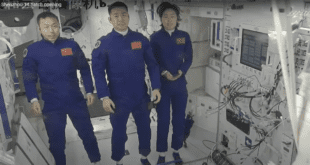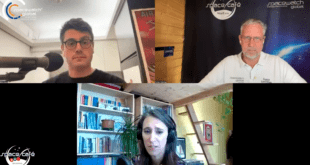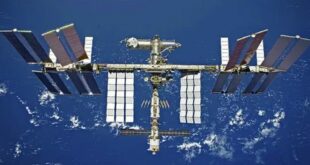by Blaine Curcio and Jean Deville
 As part of the partnership between SpaceWatch.Global and Orbital Gateway Consulting we have been granted permission to publish selected articles and texts. We are pleased to present “Dongfang Hour China Aerospace News Roundup 20 – 26 September 2021”.
As part of the partnership between SpaceWatch.Global and Orbital Gateway Consulting we have been granted permission to publish selected articles and texts. We are pleased to present “Dongfang Hour China Aerospace News Roundup 20 – 26 September 2021”.
Hello and welcome to another episode of the Dongfang Hour China Aero/Space News Roundup! A special shout-out to our friends at GoTaikonauts!, and at SpaceWatch.Global, both excellent sources of space industry news. In particular, we suggest checking out GoTaikonauts! long-form China reporting, as well as the Space Cafe series from SpaceWatch.Global. Without further ado, the news update from the week of 20 – 26 September 2021.
1) Tianzhou-3 Cargo Launch
Jean’s Take
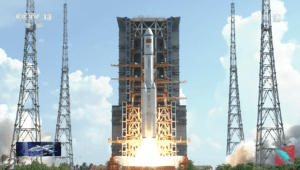 Monday, September 20 saw the launch of the Tianzhou-3 cargo spacecraft from the Wenchang Launch Center in Hainan Province, onboard a Long March-7. This is the second Tianzhou cargo spacecraft to be sent to the CSS, the first one being Tianzhou-2 in May this year.
Monday, September 20 saw the launch of the Tianzhou-3 cargo spacecraft from the Wenchang Launch Center in Hainan Province, onboard a Long March-7. This is the second Tianzhou cargo spacecraft to be sent to the CSS, the first one being Tianzhou-2 in May this year.
The launch took place successfully in what seems like a routine now with the increase of number of launches linked to the CSS:
- Rocket ignition took place at 03:10 pm Beijing time. And as the rocket increasingly gained speed, the side boosters separated, followed by the 1st stage, and at last the 2nd stage, at T+597s, and which is a point where Tianzhou-3 was on its own in LEO.
- Worth noting, at the time, while Tianzhou-3 was inserted in the correct orbit, the launch was not considered a complete success until the solar arrays and relay antenna were deployed (these are folded to fit in the payload fairing). The deployment was successfully completed roughly 10 minutes later after the separation of the 2nd stage.
Tianzhou-3 then docked successfully with the Tianhe-1 core module of the CSS about 6 and ½ hours later, in what the Chinese call “快速交会对接” or “fast rendez-vous and docking”. In total, the 4 orbital control engines at the back of Tianzhou were fired 6 times, with also assistance during the trip from the 32 attitude control engines.
The rapid pace of the rendez-vous (6 and ½ hrs) was possible thanks to the Beidou-3 satnav constellation services which became operational in 2020, as well as the increased computing power of both Tianzhou and the Tianhe-1 module. The launch window also had to be very carefully planned to enable “fast rendez-vous”.
To give a point of comparison, it took 8 hours for Tianzhou-2 to perform fast rendez-vous and docking, and it took 2-3 days for Tianzhou-1 to rendez-vous with Tiangong-2 in 2017, before the rendez-vous procedures and associated instruments were upgraded. Quite a difference.
What did the Tianzhou-3 carry? Unsurprisingly, it carried lots of supplies for the upcoming Shenzhou-13 crew, as this new batch of taikonauts will be staying 6 months in orbit starting in October 2021: an absolute record for Chinese spaceflight. Worth noting, this is still below the absolute record which is held by cosmonaut Valeri Polyakov, who stayed 437 days in the MIR space station. As for the ISS, the record will be held by US astronaut Mark Vande Hei when he returns to Earth next year from the ISS (353 days).
Back to the cargo of Tianzhou-3: there will be over 200 packages representing 5t-ish of cargo, with 2.16t dedicated solely to supplies for the taikonauts (that’s 500 kg more than TZ-2, and there’s notably 1t of water). Among the 5t were also a space EVA suit as the CSS only had two previously, experimental space sciences payloads (including seeds!), and equipment linked to the maintenance and overhaul of the station.
Last but not least, I want to mention that there was a good live coverage of the launch, both in English on CGTN and in Chinese on CCTV. As has been done in previous editions in 2020 and 2021, CCTV invited some quality guest speakers from within the Chinese space industry (CALT, CAST), making the live coverage a gold mine of information.
It also gives us a glimpse of some non-technical stuff, such as the excitement that was generated in China by the launch: the beaches of Qishuiwan, which are just opposite of the launch center, were absolutely packed with people, an unusual site in the otherwise rather small and ordinary city of Wenchang.
The excitement in China was quite in contrast with the space-related discussions internationally, where the attention was mostly focused on the Inspiration4 mission which took place a couple of days prior and which sent a crew of 4 private citizens into LEO on-board a SpaceX Crew Dragon.
2) Hainan Space Cluster Article
Blaine’s Take
An article from Xinhua on 21 September on what was an eventful week in Wenchang, Hainan Province. In addition to the Tianzhou-3 launch from Wenchang Space Launch Center and associated influx of people, we saw the 2021 Wenchang International Aviation and Aerospace Forum. These events were examples of the relatively niche, but developing space sector in Hainan, which we will unpack a little bit now.
To review, Hainan Province is an island off the southern coast of China. As a relatively less-developed province, Hainan has historically been home to agriculture, food processing, and other light industry. In recent years, there have been efforts to diversify and upgrade the island’s economy. Part of this has been the island becoming home to the Wenchang Space Launch Center in the mid-2010s, with Wenchang being China’s newest, southernmost (great for heavy launches), and most tourist-friendly launch site.
As we covered in Dongfang Hour Episode 31 among others, Wenchang’s launches have become a bit of a pop culture phenomenon in China, with people making a pilgrimage from various parts of the Mainland to Hainan Island for launches at the site (including a symphony orchestra). There is also a really epic Hilton hotel.
That being said, Wenchang has had 14 launches in the 5 years since it opened, i.e. around 1 every 4 months. This is going to increase with the increasing number of Chinese space station launches, but will remain relatively small as Wenchang is primarily focused on big rockets. Apart from the launch center, there is not a lot else in Wenchang, or indeed the rest of Hainan, in terms of space sector, beyond a few pockets such as a CAS TT&C facility in Sanya. As discussed in Dongfang Hour Episode 42, at a provincial level this is beginning to change, due to a combination of national-level support (NDRC and MOFCOM) and provincial support (space in the provincial 14th Five-Year Plan).
Emphasized during this week’s events was the Wenchang International Aerospace City, which was unveiled in June 2020 as one of 11 key industrial parks in the Hainan Free Trade Port. The project has attracted more than 30 entities, including CALT and the Aerospace Information Research Center of the CAS. The latter is notably one of China’s leading institutions for SAR technology, and may have a connection with the Hainan constellation of EO satellites given the inclusion of SAR in the constellation. CALT’s presence in Wenchang appears to be in part via its commercial subsidiary China Rocket, which aims to produce and launch the Jielong series of rockets, and is likely related to broader CALT activity at the launch sit
Also of note in Wenchang this week was the social media presence in the city. One noteworthy video circulating around the internet showed a huge traffic jam trying to move through Wenchang, with the city’s infrastructure apparently not built for such an influx of cars. The timing of the Tianzhou-3 launch, coinciding with the Forum and with the Mid-Autumn Festival holiday in China, seemed to contribute to an even bigger presence than normal in Wenchang during the launch period.
Overall, Wenchang and Hainan remain relative backwaters in China’s space sector, but they have a lot of the necessary ingredients to grow their space industry into a formidable one. Something to watch for moving forward!
3) Chinese news channel CGTN publishes a documentary named “The Quest for Space: China’s Manned Space Missions”
Jean’s Take
Last week, China’s english-language news channel CGTN released a documentary of 44 minutes, focused entirely on its space program. The documentary comes at a time where international interest in Chinese space has increased, in the vicinity of recent launches to the Chinese space station.
It gives an overview of China’s space program from the early days (first satellite and launch in 1970 with the Dongfanghong-1), to today, which can be helpful for our viewers/listeners who are not familiar with the general timeline of Chinese space over the past 5 decades. For more knowledgeable viewers, the documentary won’t bring too many new insights.
My personal appreciation of the documentary is that although narration is given from a Chinese perspective, there are nevertheless excellent and unique insights into difficulties encountered by China. Some of these include quality control issues in the 1990s (leading notably to some famous launch failures), the Shenzhou-5 window cracking during re-entry, and a fire alarm during the first EVA ever performed by China in 2008 by the Shenzhou-7 crew.
It is uncommon to see China speaking openly about issues, and even more in an English-language media destined mainly to international viewers. It highlights the increasing confidence in the country’s space capabilities, and may suggest a (progressive) step towards more open communications, notably towards the international space community.
4) Tianbing Aerospace / Space Pioneer With Another Funding Round
Blaine’s Take
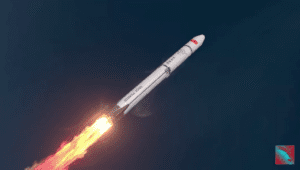 Commercial launch company Space Pioneer announced yet another funding round, led by a national SME development fund. The recent round comes around 2 months after their Pre-B round of funding, which we discussed on the DFHour Episode 44 back in August. We’ve spoken about Space Pioneer in some depth back on episode 44, so we will keep this fairly short, but from my side, I would first point out that this is the seventh funding round by Space Pioneer in the past 2.5 years, with the company having likely raised more than ~RMB 700M, from blue chip, mostly state-owned or partly state-owned investors. CEO is the former CTO of Landspace, and apparently his pedigree at the company proved useful in accelerating the development of his own.
Commercial launch company Space Pioneer announced yet another funding round, led by a national SME development fund. The recent round comes around 2 months after their Pre-B round of funding, which we discussed on the DFHour Episode 44 back in August. We’ve spoken about Space Pioneer in some depth back on episode 44, so we will keep this fairly short, but from my side, I would first point out that this is the seventh funding round by Space Pioneer in the past 2.5 years, with the company having likely raised more than ~RMB 700M, from blue chip, mostly state-owned or partly state-owned investors. CEO is the former CTO of Landspace, and apparently his pedigree at the company proved useful in accelerating the development of his own.
It’s also noteworthy to see the inclusion of “satellite internet” from the NDRC in their press release. This implies a certain degree of confidence in Space Pioneer’s rockets addressing satellite internet-related demand (i.e. launching LEO broadband satellites). Indeed, the company mentioned that:
“Facing the huge market demand (for broadband satellites)…..only a company with a strong technical team, the ability to continuously innovate in core technology, and continuous “cultivation” breakthroughs In order to go solidly and go further.
As my country’s commercial aerospace industry, Tianbing Technology is the first high-tech enterprise to develop a new generation of medium and large liquid carrier rockets”
Finally, the mention of the company’s Suzhou production park, which broke ground in April 2021. The Yangtze River Delta is indeed home to an increasing number of secondary or tertiary facilities for commercial launch manufacturers, including Deep Blue Aerospace, Landspace, Rocket Group, JZYJ (if you count Bengbu as YRD, which most would not). This all in addition to SAST, which builds some pretty big rockets in that area too. Something to watch for moving forward–how these clusters develop
And with that, this has been another episode of the Dongfang Hour China Space News Roundup, this for the week of the 20-26 September, 2021. For a bunch more insights on other current pieces of Chinese space industry news, check out the Dongfang Hour Newsletter at newsletter.dongfanghour.com
This has been another episode of the Dongfang Hour China Space News Roundup. If you’ve made it this far, we thank you for your kind attention, and look forward to seeing you next time! Until then, don’t forget to follow us on YouTube, Twitter, or LinkedIn, or your local podcast source.
Blaine Curcio has spent the past 10 years at the intersection of China and the space sector. Blaine has spent most of the past decade in China, including Hong Kong, Shenzhen, and Beijing, working as a consultant and analyst covering the space/satcom sector for companies including Euroconsult and Orbital Gateway Consulting. When not talking about China space, Blaine can be found reading about economics/finance, exploring cities, and taking photos.
Jean Deville is a graduate from ISAE, where he studied aerospace engineering and specialized in fluid dynamics. A long-time aerospace enthusiast and China watcher, Jean was previously based in Toulouse and Shenzhen, and is currently working in the aviation industry between Paris and Shanghai. He also writes on a regular basis in the China Aerospace Blog. Hobbies include hiking, astrophotography, plane spotting, as well as a soft spot for Hakka food and (some) Ningxia wines.


